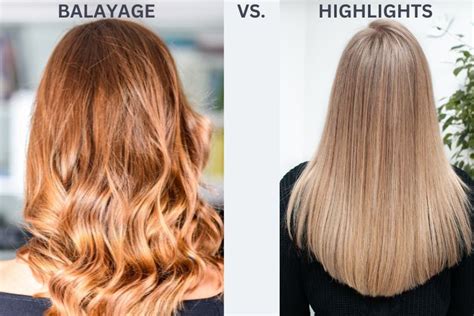Introduction
Balayage and highlights are two popular hair painting techniques that can transform your look and add a touch of glamour. But what’s the difference between the two? And which one is right for you?

Balayage vs Highlights: Key Differences
1. Application Technique
- Balayage: Balayage is a freehand technique where color is painted onto the hair using a sweeping motion. This creates a subtle, natural-looking effect.
- Highlights: Highlights are applied using foils or a cap to isolate strands of hair. The color is then applied to these strands, creating a more defined look.
2. Root Blending
- Balayage: Balayage has a seamless root blend, making it low-maintenance and suitable for all hair colors.
- Highlights: Highlights have a more noticeable root line, which may require touch-ups every 4-8 weeks.
3. Placement
- Balayage: Balayage is typically applied throughout the hair, including the roots.
- Highlights: Highlights are typically placed in specific areas, such as the crown, face-framing sections, or tips.
4. Intensity
- Balayage: Balayage creates a subtle, sun-kissed look.
- Highlights: Highlights can be more intense, resulting in more dramatic results.
Which Technique is Right for You?
Factors to Consider:
- Hair color and texture
- Desired level of contrast
- Maintenance preferences
- Lifestyle and budget
General Guidelines:
- Balayage: Ideal for dark hair or those who prefer a natural, low-maintenance look.
- Highlights: Ideal for light hair or those who want a more defined, dramatic effect.
Benefits of Balayage and Highlights
Balayage:
- Seamless root blend
- Natural-looking results
- Suitable for all hair types
Highlights:
- More defined contrast
- Adds dimension and depth to hair
- Can brighten up dull hair
Common Mistakes to Avoid
Balayage:
- Over-applying color
- Using too wide of a brush
- Not blending enough
Highlights:
- Over-processing the hair
- Using too much heat
- Not foiling properly
Tips and Tricks
Balayage:
- Use a fine-toothed comb to blend the color seamlessly.
- Apply color to damp hair for better penetration.
- Allow extra time for processing to achieve the desired results.
Highlights:
- Use foils to create a more precise effect.
- Tone the hair after highlighting to neutralize any brassiness.
- Use heat protectant spray to minimize damage from heat styling.
Frequently Asked Questions
1. How long do balayage and highlights last?
- Balayage lasts up to 3-4 months, while highlights last 6-8 weeks.
2. How often should I get touch-ups?
- Balayage touch-ups are less frequent (~4 months) compared to highlights (~6-8 weeks).
3. Is balayage or highlights more expensive?
- Both techniques vary in price depending on hair length, the amount of color used, and the salon. Generally, balayage is slightly more expensive than highlights.
4. Can I do balayage or highlights at home?
- It’s not recommended to perform balayage or highlights at home without professional training.
5. What are the pros and cons of each technique?
- Balayage: Pros: natural-looking, low-maintenance; Cons: may not achieve as much contrast as highlights.
- Highlights: Pros: defined contrast, adds dimension; Cons: more noticeable root line, requires more maintenance.
6. Which technique is better for my hair type?
- Balayage is ideal for dark or fine hair, while highlights are suitable for light or medium-textured hair.
Conclusion
Whether you opt for balayage or highlights, both techniques can create beautiful, eye-catching results. By understanding the key differences, benefits, and risks associated with each technique, you can make an informed decision that suits your hair goals.
